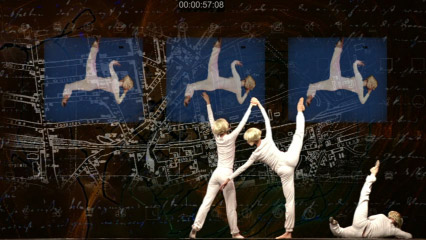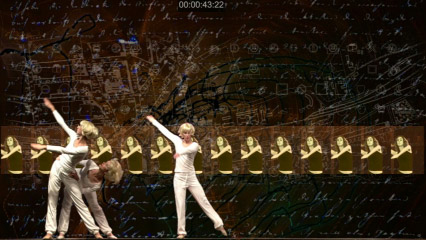-Barry Edwards and Ben Jarlett
○Music and sound are the key ingredients in Optik.
1st Optik ('81-'86)
-singing ballad
-live acoustic solo instrument
-highly structured
-colliding the unexpected with familiar
-the formal with everyday
-the spoken word with gesture
-No improvisation
2nd Optik(’92~)
- percussion instrument
(drums, cymbals, marimbar...)
-ambient/found sound (foot-steps, breathing, laughter...)
-Use of improvisation
○Optik 2000
•To attempt an electronic experiment
(London studio ~(internet)~ Sao Paulo)
•live electronic sound : new element in Optik performance
A Tele-Presence Experiment: Optik in Sao Paulo + London
http://people.brunel.ac.uk/bst/1nol2/Barry%20Edwards/Barry%20Edwards%20-%20Optik.htm
○1st cycle Optik (blocks)
•electronic segment sound → whole sound score
•layering and juxtapositon became a hallmark of directing and creative style
•Optik excel at such moments, where the visual and the aural experiences meld and boundaries divide(Stella Hall)
○2nd cycle Optik (waves)
•wave-like transitions and emergent moments of event and action
•Optik explore moving. And… (Tracey Warr)
•Based on the dynamics of the human body in space and time
―The sound artist works as a performer : not ‘bolting on’ predetermined sound
○Part of pleasure of live performance
•The performers are drawing attention to themselves, in that space/moment
•Mixed ingredients in a space of performance
―The size, shape and acoustics of a space, of the performers and spectator in it
○Intuition : Sense of connectedness or oneness
•Aa a constant play/opposition with the sense of singular, uniqueness that each one of us
•As spectators and performers, we have an intuitive knowledge of this, of the essence of this connection
•The play between structure and chaos in performance demonstrates that theatre form and process are dynamic and can never be fixed.
○Eidetic intuition : performer-space-spectator in theatre
•Theatre is a process of flux
•The immediate knowledge of the form of something (vivid and present)
•Theatre : the material physical dynamics of the performer-space-spectator relationship to produce transformations in the human form itself.
○Impulse(자극) into action, which results in all movement and sound, is an all or nothing thing.
○It is always more interesting if the resolution of the impulse is left as potential for as long as possible.
○Repeating=paradox
○The impulse of sound and vision for performance opens up many creative possibilities.
○The essence of improvisation as a technique is that nothing stays the same for very long, change is constant, and wave-like.
○instantons
○diagetic = diegetic (cinematic term)
•Sound in films is termed ‘diegetic’ if it is part of the narrative sphere of the film
•Diagetic : Character playing instrument or turning on CD player
•Non-diegetic : background music
○The sound in recent Optik work is ‘diagetic’
•the source of sound is always present, not imported.
○Diegesis in film
•Diegetic mode
•Mimetic mode
○Granulab : granular synthesiser - simply to playback a sound file and loop.
○Looping/Rhythm/Texture
○Granulab T5
○VJ software
○director and sound technologist
○Independently creativity from interactive software
○driven by search for human content, human interest, the human story
○Optik : the most ancient of instruments and techniques with one of the most contemporary, exemplifying the artist-led nature of Optik's work.
○Optik, Performance and Processing (by Ben Jarlett)
http://people.brunel.ac.uk/bst/vol0602/benjarlett/benjarlett.pdf
○Barry Edwards
http://www.brunel.ac.uk/about/acad/sa/artstaff/drama/barryedwards
○Optik.tv
http://www.optikweb.pwp.blueyonder.co.uk/

